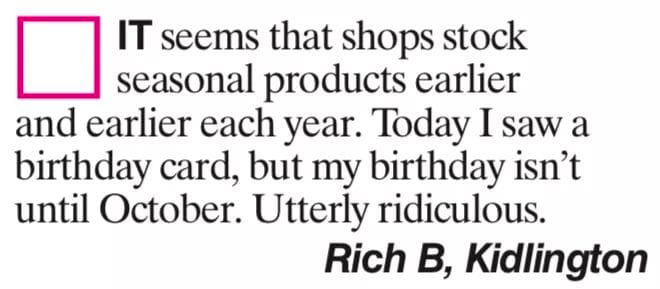It’s six months til Christmas. What do you mean you haven’t finalised your marketing plan for it yet?
The reason I chose the above image is twofold. First, it made me chuckle. Second, it’s a crude segway into the fact this piece is about a Christmas campaign. And it’s June. Yep.
For marketers of course the reality is if you haven’t at least started planning your Christmas activities yet, you’re cutting it fine.
It’s always amazed me how many Aussie advertisers rely on some pretty heavy Northern Hemisphere Christmas stereotypes for Christmas campaigns. Snow, elves, reindeer. It’s all very alien to the 35-degree days we’re experiencing.
Department store Myer is synonymous with Christmas for many Australians. Alongside rivals David Jones it has been perpetuating the snow-fuelled imagery in its Christmas campaigns in recent years, with big brand ads featuring ALL of the tropes.

They were animated by the studios behind Wallace and Gromit and was a massive and expensive undertaking which took months of painstaking production, and needed a massive media budget to support it. It’s not that they were bad ads, it’s just that for me, they didn’t resonate.
Given the well-documented more straightened environment at Myer, the opportunity and need was there to do something different. A risk, but a calculated and necessary one.
It’s fascinating listening to Clemenger BBDO Melbourne’s Gayle While recounting the story of Myer’s last Christmas campaign (which you can hear in the latest episode of the Face 2 Face podcast).
The premise is simple – it’s a bauble that changes colour from green to red at the touch of a button. It’s actually a behaviour-change device – allowing parents to make their kids behave themselves by showing if they are on Father Christmas’ naughty or nice list.
But what they had done is give Myer an excuse to talk to people on a regular basis in the most important retail time of the year, and be front and centre in thousands of Christmas conversations on social media.
That suddenly made a reduced media budget work an awful lot harder.
For me, it works for a few reasons:
- It created a new tradition for families to participate in – and what is Christmas if not a time for a little tradition (why else do we go and hang out with our in-laws for days on end when we’d never do that any other time of year?).
- It tapped into an insight that parents love to share shit their kids do on social media (and yes I’m guilty of this). Anyone with friends with young kids will no doubt have been subjected to Elf on the Shelf videos in the build up to Christmas, and this is essentially the mechanised version of that.
- The campaign was agile, and well planned. When they sold out the baubles quicker than expected the agency pivoted the campaign switching out the TV ad, and utilising outdoor media and the data from the app to tell Victorians they were 63% good today, or NSW it was on the naughty list.
- It’s not the most creative campaign of last Christmas, but it’s arguably the most creative idea. All the executions were simple, but the campaign as a whole worked across different touchpoints.
- It was authentic. Trust me, that’s not a word I use lightly. It brought the nostalgia whilst marrying it with technology, making Myer both a traditional home of Christmas, but not making it look old fashioned. That speaks a lot to the brand and perception.
- Of course there’s also a more subtle retail message, after all the threat to the kids only works if you have a gift to threaten to withhold from them.
And as Gayle admitted, it wasn’t perfect by any stretch of the imagination. It was executed relatively quickly, and there is scope for Myer to make it more of a data play around consumer behaviour by marrying purchases up to its Myer One program, to learn more about its customers.
I wrote a piece a little while ago about the disappearance of creative technologists from the creative agency scene, and highlighted a few of the more gimmicky ‘prototypes’ the industry was chucking into the ether for a while in pursuit of metal.
This Myer campaign is a great example of how the industry has matured and grown more comfortable with technology, and started to discover how it can turn novel ideas into something which will be part of households for years to come.
I’m off to pick up my first mince pies of the season…




